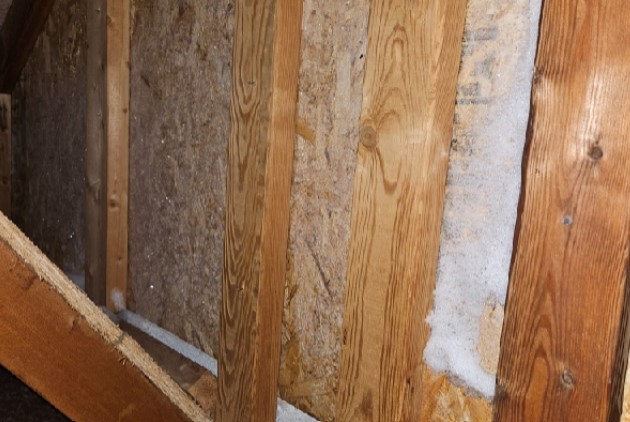Ceiling water spots growing? It may be condensation and time to check your insulation!
Over the last couple weeks, I’ve received several referrals from roofing companies and talked to customers having issues with water spots on their ceilings, especially after the snow like Kansas City experienced last week starts melting. Many homeowners believe this to be caused by a roof leak, but it’s likely a much more complicated issue – Condensation.
Condensation occurs when warm, moist air comes into contact with cooler surfaces, such as windows, walls, ceilings and roof decks. The warm, humid air cools down and releases moisture in the form of water droplets against these services. In extreme cold periods like we just experienced these water droplets freeze against these surfaces such as can lights, exhaust fans, and/or against the roof decking. When warm weather follows the freeze, those frozen droplets thaw and effects can be devastating to your home and family’s health.
Over time, this excess moisture can lead to significant issues, including mold growth, wood rot, and damage to paint and wallpaper. These problems not only compromise the aesthetic appeal of your home but can also pose serious health risks, as mold spores can trigger respiratory issues and allergies.
What can a homeowner do to stop condensation from forming?
The good news is that we at Star Companies have been solving these problems for 40 years! Every home is different, and we assess the full health and condition of the home to develop the right strategy to correct the issue. There are 3 main conditions that create condensation in a home.
- Make sure your home is well insulated & air sealed
- Proper ventilation into the attic
- Minimize humidity levels in the home
Proper Insulation & Air Seal
The most effective way to combat condensation is through proper insulation levels and sealing air penetrations. Insulation helps to maintain a stable indoor temperature by preventing warm or conditioned air from escaping, and cold or unconditioned air from entering the living space. Additionally, well-insulated homes often have better airflow in the living space, which helps to balance humidity levels. This not only minimizes the risk of condensation but also promotes overall indoor air quality.
Proper Attic Ventilation
Proper ventilation to the attic space allows moisture and humidity to disperse and evaporate. Everything from incorrectly installed baffles, blocked soffit vents and/or baffles, to simply a poor design with no vent in that back corner of the home over an ensuite bathroom… this all can create a perfect environment for moisture to form and stay in the attic, causing the host of issues mentioned earlier. Unfortunately, this is a very common reason we see condensation and issues caused by moisture to homes.
Humidity in your Home
I know many out there are like me when this cold, dry air comes in, my sinuses are begging for humidity (especially overnight), as well as dry skin. To combat this discomfort, many run to the humidifier on your HVAC turning to the max. Or, taking that extra long hot shower to breathe in the steam.
Unfortunately, these situations are creating moisture that will eventually make its way to the attic of an under-insulated home. When we see extreme temperatures, this moisture freezes almost as soon as it touches a cold surface, waiting for the sun or a warm day to melt and fall on your ceiling and creating the beautiful brown spots that stick out like a sore thumb.
As mentioned above, adding insulation, air sealing and making sure your attic has the needed air circulation are the best ways to manage and mitigate condensation. But this won’t stop all moisture without also managing humidity levels in the home. This is also why we see frozen walls and outlets during extreme cold temperatures. Here are a few more strategies to stop condensation taking over your home.
- When temps get below 20*, minimize or turn off your humidifier. I know this doesn’t create the most comfortable conditions but is better than adding to your “honey-do list” or creating long-term damage to your home.
- If needing a humidifier, use an individual unit in the needed rooms. This limits to areas in use, rather than the whole house at all times.
- Try to limit shower time. I know this is a hot topic in many homes, but I’m hopeful this information at least makes you more aware. This is also a reason to make sure your home is well insulated and tightly air sealed, especially over bathroom lights and fans.
- Set your HVAC fan to ON – The fan on your HVAC will pull in air throughout the home, clean, dehumidify and redistribute the air. The continuous air movement gives humid air less likely to make it into the attic’s unconditioned space where the warm air meets… see top of page, and around we go!
- When you see forecasts in the single digits or below, lower the humidity level ASAP. Even with your HVAC Fan on, it will take a few days to clean out the excess humidity. If the temps get to -10 and below, it’s very likely that humidity will catch and freeze on the walls and outlets, creating a cycle of issues.
Conclusion
I know this is a lot of information and a little wordy but unfortunately, it’s a conversation I’ve been having almost daily for the last two weeks. Every home is different, and we want to provide homeowners with information to decide what is best for your situation. At Star, we provide a FREE full assessment of every customer’s home to find and put all the puzzle pieces together. We identify the problem or opportunity and collaborate to develop the right strategy for your needs.
Simply, if your attic insulation is under 12 inches in depth, your home is severely under-insulated for today’s standards. Admittedly, before I started working in insulation, I didn’t look in any of my previous homes’ attics, so I am more than happy to look at your home to give an honest opinion with all the cards on the table and develop a strategy that fits your needs and budget. At the end of the day, we are insulation installers, but there are real consequences that can have lasting impacts to a home over simply installing and blowing insulation.
Investing in quality insulation and the right services can lead to long-term savings on energy bills and reduce the potential for costly repairs caused by moisture-related issues. Addressing condensation effectively through these steps and strategies are key to maintaining a healthy, comfortable home.
For homeowners in the Kansas City metro area, choosing Star Companies, Inc. for insulation services means investing in a comfortable, cost-effective, and energy-efficient future. Experience the benefits of enhanced comfort, increased home value, and energy savings by contacting Star Companies today. Make the smart choice to insulate your home professionally and enjoy the tangible benefits year after year.
Posted in Home Insulation

